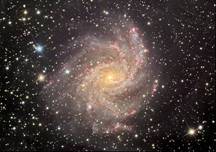 |
| Sorry Luke... |
1) Betelgeuse is the second largest known star in the universe. Wrong - it ranks around 10th in our galaxy.
2) It could go supernova as early as 2012. Wrong - it go go any day, but there is no new evidence saying it will go by 2012. This infamous date was added for effect (bravo reporter, sarcastic clap clap). We will have no warning about it. It could go today or 1,000 years from now.3) When Betelgeuse explodes it will be as bright as the Sun and there will be no night for days. Wrong - astronomers estimate that it will be no brighter than a full moon and won't appear that large. From past accounts of supernovas, it should be bright enough to be visible in the day time - like a really, really bright star, and not bright enough to vanquish nighttime.
4) This will affect the Earth. Wrong - Betelgeuse is so far away (over 600 light years) that the radiation, gamma rays, and other nasty stuff won't reach the Earth.
 |
| Tycho's Supernova |
The eventual exploding of Betelgeuse is not news. I'm hopeful that it will explode in my lifetime, but I'm not holding my breath. We're definitely due for a bright supernova. The last two bright enough to be visible day and night were in 1572 and 1604. (Those guys in the Renaissance had all the luck!). The Supernova of 1572 was described in great detail by Tycho Brahe, Danish astronomer and loser of a nose in a mathematics-themed sword fight. It shows up on old stars charts in the constellation Cassiopeia. The Supernova of 1604 is often called Kepler's Supernova from the German astronomer Johannes Kepler, who came out of Brahe's shadow to become the leading astronomer of the 1600s. Both of these supernovas blazed for weeks. I can't wait to see one... any day now ;)
"Two Suns?" what poppycock!
Signed,
The Crabby Astronomer
-










